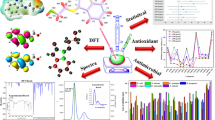Three new heavy metal complexes of gemifloxacin (GMFX) were synthesized in 2:1 (L:M) ratio having good percent yield, characterized through physico-chemical and spectroscopic parameters including UV-Vis, TLC, FT-IR, NMR, and elemental (CHN) analysis. The gemifloxacin binds with metals (As, Ag, and Pb) bi-dentately as evident from the spectroscopic studies. These newly synthesized heavy metal complexes of gemifloxacin have been evaluated for their biological activities (antimicrobial and antifungal activities). Their enzymatic profiling was also determined against urease and alpha-chymotrypsin. Results obtained were then statistically analyzed through one way ANOVA and Dunnett’s test by using SPSS version 20.0 revealing that gemifloxacin act as bidentate ligand in complexation with heavy metals, and all newly synthesized complexes possess good antibacterial activities against P.mirabilis, S. typhi, E. coli, P. aureogenosa, K. pneumonia and S. flexneri. Complexes G-M13 and G-M11 showed increased activity against Citrobacter species, while G-M12 showed increased activity against C. albicans in comparison to gemifloxacin. Against S. faetures and S. aureus, G-M13 and G-M12 showed increased activity while G-M11 showed less activity than gemifloxacin. These complexes also possess mild to moderate activity against urease, whereas synthesized complexes show reduced response against α-chymotrypsin. Further emphasis and research on these complexes may place these as urease specific inhibitors in therapeutic agents’ index.




Similar content being viewed by others
References
A. Albert, in: Selective Toxicity. The Physico-Chemical Basis of Therapy, Chapman & Hall, London (1979), pp. 421 – 427.
M. N. Hughes, in: The Inorganic Chemistry of Biological Processes, John Wiley, New York (1981), pp. 177 – 181.
E. K. Efthimiadou, S. Sanakis, N. Katsaros, et al., Polyhedron, No. 26, 1148 – 1158 (2007).
K. Martin and M. S. Hosam, in: Introductory Chapter: An introduction to Trace Elements (2018). https://doi.org/10.5772/intechopen.75010
I. Turel, Coord. Chem. Rev., No. 232, 27 – 47 (2002).
I. Turel, I. Leban and N. Bukovec, J. Inorg. Biochem., No. 56, 273 – 282 (1994).
S. C. Wallis, L. R. Gahan, B. G. Charles, et al., J. Inorg. Biochem., No. 62, 1 – 16 (1992).
Z. F. Chen, R. G. Xiong, J. Zhang, et al., Inorg. Chem., No. 40, 4075–4077 (2001).
I. Turel, K. Gruber, I. Leban, and N. Bukovec., J. Inorg. Biochem., No. 61, 197 – 212 (1996).
Z. F. Chen, L. Bai-Qin, Y. R. Xie, et al., Inorg. Chem. Comm., No. 4, 346 – 349 (2004).
L. Z. Wang, Z. F. Chen, X. S. Wang, et al., Chin. J. Inorg. Chem., No. 18, 1185 – 1190 (2002).
N. Sultana, M. S. Arayne, S. Gul, and S. Shamim., J. Mol. Struct., No. 975, 285 – 291 (2010).
S. Arayne, N. Sultana, U. Haroon, and M. A. Mesaik., Bioinorg. Chem. Appl. (2009). https://doi.org/10.1155/2009/914105
N. Sultana, A. Naz, M. S. Arayne, and M. A. Mesaik., J. Mol. Struct., No. 969, 17 – 24 (2010).
S. Gul, N. Sultana, M. S. Arayne, et al., J. Chem. (2013). Article ID 306385.
P. MacCarthy., Anal. Chem., No. 50, 2165 (1978).
R. A. Marusak, K. Doan, and S. D. Cummings, in: Integrated Approach to Coordination Chemistry: an Inorganic laboratory Guide, Experiment 3.6: Visible Spectroscopic Analysis and Job’s Plot, Willey Interscience., John Willey & Sons. Inc. (2007), pp. 75.
EUCAST. Antimicrobial Susceptibility Testing. EUCAST Disk Diffusion Method. Version 6.0, 2017. http://www.eucast.org/astofbacteria/previousversionsofdocuments/
E. Jonasson, E. Matuschek, and G. Kahlmeter., J. Antimicrob., 75(4), 968–978 (2020).
R. Sharma, K. Tiwari, V. M. Belmar, et al., BMRJ, 11(4), 1 – 8 (2016).
M. Akhtar, N. Sultana, M. S. Arayne, et al., Pak. J. Pharm. Sci., 32(3), 1301 – 1306 (2019).
M. H. Badraddin and A. M. Mahmoud, Profiles Drug Subst. Excip. Relat. Methodol., No. 6, 151 – 168 (2011).
C. S. Paima, F. Führa, M. T. Martinsa, et al., Biomed. Chromatogr., No. 30, 459 – 465 (2016).
D. L. Pavia, G. M. Lampman, and G. S. Kriz, in: Introduction to Spectroscopy: A Guide for Students of Organic Chemistry, Brooks / Cole, Philadelphia, (2009).
Conflict of Interests
The authors declare that they have no conflict of interest regarding the publication of this paper.
Author information
Authors and Affiliations
Contributions
All the authors have contributed equally to this work.
Corresponding author
Rights and permissions
About this article
Cite this article
Shamim, S., Gul, S., Khan, A. et al. Antimicrobial, Antifungal and Enzymatic Profiling of Newly Synthesized Heavy Metal Complexes of Gemifloxacin. Pharm Chem J 55, 1033–1039 (2022). https://doi.org/10.1007/s11094-021-02534-6
Received:
Published:
Issue Date:
DOI: https://doi.org/10.1007/s11094-021-02534-6




